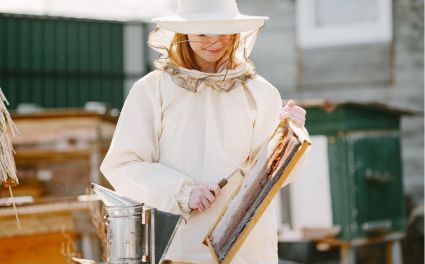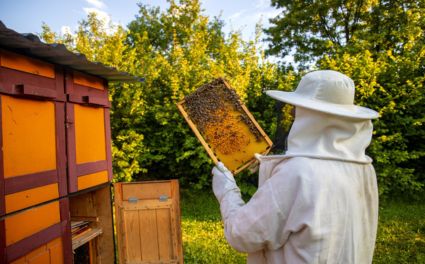Der Bienenkönigin ist das Herzstück eines Bienenstocks und spielt eine entscheidende Rolle für die Stabilität und Produktivität des Bienenvolkes. Der Tod der Bienenkönigin kann den Bienenstock in eine Krise stürzen. Als Imker ist es wichtig zu wissen, wie man mit dieser Situation umgeht, um das Überleben und die Gesundheit des Bienenstocks zu sichern. In diesem Artikel erfahren Sie, wie Sie die Herausforderungen des Bienenköniginnentodes meistern – vom frühzeitigen Erkennen der Anzeichen bis hin zur erfolgreichen Umweiselung des Bienenstocks.
Die Dynamik des Bienenstocks verstehen, wenn die Bienenkönigin stirbt
Bienenstockdynamik und Kolonieverhalten
Wenn eine Bienenkönigin stirbt, verändert sich die Dynamik des Bienenstocks dramatisch. Die Pheromone der Bienenkönigin, die das Verhalten und den Zusammenhalt des Bienenstocks regulieren, beginnen sich aufzulösen. Ohne diese Pheromone können die Arbeiterinnen desorientiert und weniger effizient in ihren Aufgaben werden. Das Fehlen der Königin bedeutet auch, dass keine neuen Eier gelegt werden, was den zukünftigen Bestand des Bienenstocks gefährdet.
Rolle der Arbeiterbienen
In Abwesenheit der Königin übernehmen die Arbeiterbienen eine entscheidende Rolle bei der Erhaltung des Bienenstocks. Sie versuchen oft, aus vorhandenen Larven eine neue Königin aufzuziehen, doch dieser Prozess kann mit Herausforderungen verbunden sein. Die Fähigkeit der Arbeiterbienen, diesen Übergang erfolgreich zu meistern, bestimmt das Überleben des Bienenstocks in dieser kritischen Phase.

Die Anzeichen einer sterbenden oder toten Bienenkönigin erkennen
Gemeinsame Indikatoren
Die frühzeitige Erkennung einer sterbenden oder toten Bienenkönigin ist für ein effektives Bienenstockmanagement unerlässlich. Zu den Anzeichen, auf die Sie achten sollten, gehören:
- Verringerte Eiablage: Ein deutlicher Rückgang der Anzahl der gelegten Eier kann auf eine versagende Königin hinweisen.
- Unberechenbares Verhalten: Arbeiter können ungewöhnliches Verhalten oder erhöhte Aggressivität zeigen.
- Königinnenloses Brüllen: Eine deutliche Veränderung im Geräusch des Bienenstocks, oft lauter und chaotischer.
- Mehrere Not-Weisselnzellen: Arbeiterinnen beginnen möglicherweise in einem verzweifelten Versuch, eine neue Königin aufzuziehen, mit dem Bau zahlreicher Weiselzellen.
Früherkennung ermöglicht ein rechtzeitiges Eingreifen und verringert das Risiko eines Bienensterbens. Regelmäßige Bienenstockinspektionen und ein wachsames Auge auf Verhaltensänderungen im Bienenstock können Ihnen helfen, Probleme frühzeitig zu erkennen.
Sofortmaßnahmen beim Tod der Bienenkönigin
Notfallmaßnahmen für die Bienenhaltung
Wenn Sie feststellen, dass die Bienenkönigin gestorben ist, ergreifen Sie sofort Maßnahmen zur Stabilisierung des Bienenstocks:
- Beruhige die Kolonie: Verwenden Sie einen Smoker, um die Bienen zu beruhigen und Stress zu minimieren.
- Bewerten Sie die Situation: Untersuchen Sie den Bienenstock gründlich, um das Fehlen der Königin zu bestätigen und den Zustand der Kolonie zu beurteilen.
- Notweiselzellen entfernen: Wenn die Kolonie nicht für die Aufzucht einer neuen Königin geeignet ist, entfernen Sie Not-Königinnenzellen, um die Einführung einer neuen Königin vorzubereiten.
Gewährleistung von Gesundheit und Sicherheit
Stellen Sie sicher, dass der Bienenstock frei von Schädlingen und Krankheiten ist, die die Krise verschlimmern könnten. Sorgen Sie für ausreichend Nahrung und optimale Bedingungen im Bienenstock, um die Bienen in dieser stressigen Zeit zu unterstützen.
Der Umweiselungsprozess
Beim Umweiseln wird eine neue Königin vorsichtig in den Bienenstock eingeführt. So geht's:
- Wähle eine neue Königin: Wählen Sie eine gesunde, begattete Königin aus einer seriösen Quelle.
- Stellen Sie den Königinnenkäfig vor: Setzen Sie die neue Königin in einen Königinnenkäfig mit einem Zuckerstopfen. Setzen Sie den Käfig in den Bienenstock ein.
- Akzeptanz überwachen: Geben Sie den Arbeiterinnen Zeit, die neue Königin zu akzeptieren. Sie werden den Zuckerpfropfen durchkauen und die Königin nach und nach freigeben.
- Verhalten beobachten: Achten Sie auf Anzeichen von Akzeptanz oder Ablehnung.Wenn die Arbeiterinnen gegenüber dem Käfig aggressiv sind, ist mehr Zeit erforderlich.
Tipps für einen erfolgreichen Übergang
- Füttere den Bienenstock: Sorgen Sie dafür, dass die Bienen ausreichend Nahrung haben, um Stress zu vermeiden.
- Störungen minimieren: Vermeiden Sie während der Akzeptanzphase häufige Inspektionen des Bienenstocks, damit sich die Kolonie anpassen kann.
Steuerung der Bienenstockdynamik während des Umweiselungsprozesses
Verhalten der Arbeiterbienen
Arbeiterbienen können während der Umweiselung unterschiedliche Verhaltensweisen zeigen. Das Verständnis dieser Verhaltensweisen kann helfen, den Bienenstock effektiv zu verwalten:
- Anfängliche Aggression: Eine gewisse anfängliche Aggression gegenüber der neuen Königin ist normal. Verwenden Sie bei Bedarf ein Absperrgitter, um die neue Königin zu schützen.
- Fütterung und Pflege: Sobald die neue Königin akzeptiert ist, werden die Arbeiterinnen sie füttern und pflegen, was auf eine erfolgreiche Integration hindeutet.
Überwachung des Bienenstocks
Regelmäßige Überwachung ist in dieser Zeit unerlässlich. Achten Sie auf Anzeichen einer erfolgreichen Einführung der Königin:
- Eiablage: Die neue Königin sollte innerhalb einer Woche mit dem Eierlegen beginnen.
- Ruhiges Verhalten: Der Bienenstock sollte wieder zu einem normalen Aktivitätsniveau zurückkehren, was auf weniger Stress hindeutet.
Sicherstellung des langfristigen Überlebens und der Gesundheit des Bienenstocks
Strategien für langfristiges Management
Konzentrieren Sie sich nach der erfolgreichen Umweiselung auf die langfristige Gesundheit des Bienenstocks:
- Regelmäßige Inspektionen: Führen Sie weiterhin regelmäßige Inspektionen des Bienenstocks durch, um die Leistung der Königin und die allgemeine Gesundheit des Bienenstocks zu überwachen.
- Schädlings- und Krankheitsbekämpfung: Führen Sie regelmäßige Maßnahmen zur Schädlings- und Krankheitsbekämpfung durch, um eine gesunde Bienenstockumgebung aufrechtzuerhalten.
- Ernährung: Sorgen Sie für eine konstante Nahrungsversorgung des Bienenstocks, insbesondere in Zeiten der Nahrungsknappheit.
Vorbeugende Maßnahmen
Implementieren Sie vorbeugende Maßnahmen, um zukünftige Krisen zu vermeiden:
- Königinnenüberwachung: Überprüfen Sie regelmäßig die Gesundheit und Produktivität der Königin.
- Genetische Vielfalt: Erwägen Sie die Verwendung von Königinnen aus unterschiedlichen genetischen Linien, um die Widerstandsfähigkeit der Kolonie zu erhöhen.
Praktische Imker-Tipps zum Krisenmanagement
Zusätzliche Tipps für Imker
Um einen Bienenstock durch die Krise des Verlusts einer Bienenkönigin zu führen, sind praktische Fähigkeiten in der Bienenhaltung erforderlich:
- Bleib ruhig: Bienen spüren Ihren Stress. Nähern Sie sich dem Bienenstock ruhig und methodisch.
- Bilden Sie sich weiter: Bilden Sie sich kontinuierlich über Bienenhaltungspraktiken und Krisenmanagement weiter.
- Suchen Sie Unterstützung: Treten Sie lokalen Imkergemeinschaften oder Foren bei, um Unterstützung und Rat zu erhalten.
Häufige Fehler, die Sie vermeiden sollten
Vermeiden Sie diese häufigen Fehler, um einen reibungslosen Übergang zu gewährleisten:
- Den Prozess beschleunigen: Geben Sie dem Bienenstock Zeit, die neue Königin zu akzeptieren. Geduld ist der Schlüssel.
- Den Bienenstock vernachlässigen: Regelmäßige Pflege und Überwachung sind besonders während der Umweiselung unerlässlich.
- Anzeichen einer Ablehnung ignorieren: Wenn die Bienen die neue Königin ablehnen, handeln Sie schnell, um eine andere Königin einzuführen oder den Bienenstock auf andere Weise zu unterstützen.

Rüsten Sie sich mit Imkeranzügen und Handschuhen von OZ Armour aus
Wenn Sie Ihren Bienenstock durch die Krise des Todes einer Bienenkönigin führen, ist es wichtig, für Ihre Sicherheit und Ihr Wohlbefinden zu sorgen.OZ Armour bietet hochwertige Imkeranzüge Und Imkerhandschuhe Entwickelt, um maximalen Schutz vor Stichen zu bieten und gleichzeitig den Komfort bei der Inspektion und Wartung des Bienenstocks zu gewährleisten. Unsere Imkeranzüge bestehen aus strapazierfähigen, atmungsaktiven Materialien und sorgen dafür, dass Sie geschützt bleiben, ohne zu überhitzen.
Unsere Imkerhandschuhe bieten hervorragende Fingerfertigkeit und Schutz, sodass Sie Ihre Bienen sicher behandeln können. Mit der Investition in zuverlässige Schutzausrüstung von OZ Armour können Sie Ihren Bienenstock auch in schwierigen Zeiten effektiv und sicher verwalten.
Abschluss
Der Tod einer Bienenkönigin ist ein kritisches Ereignis, doch mit der richtigen Vorgehensweise können Sie Ihren Bienenstock effektiv verwalten. Erkennen Sie frühe Anzeichen einer sterbenden oder toten Königin und ergreifen Sie umgehend Maßnahmen zur Stabilisierung des Bienenstocks. Erfolgreiches Umweiseln und die Überwachung des Verhaltens der Arbeiterinnen sind entscheidend für die Erholung. Sorgen Sie für eine langfristige Gesundheit des Bienenstocks durch regelmäßige Inspektionen, Schädlingsbekämpfung und richtige Ernährung. Beugen Sie zukünftigen Krisen durch genetische Vielfalt und konsequente Königinnenüberwachung vor. Rüsten Sie sich mit OZ-RüstungHochwertige Imkeranzüge und Handschuhe für eine sichere Bienenstockhaltung. Mit diesen Schritten stellen Sie sicher, dass Ihr Bienenstock gesund und produktiv bleibt.












